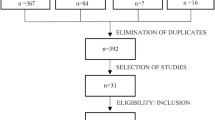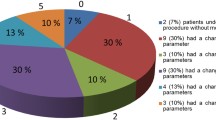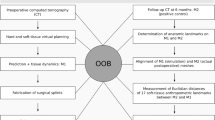Abstract
Aim
To evaluate the utility of an individualized template for corrective surgeries for patients suffering from mandibular asymmetry.
Materials and method
Twenty patients with history of favorable clinical outcome of the correction of their mandibular asymmetry were chosen. CBCTs were taken before and 6 weeks postoperative using NewTom 3G. Each volume is mirrored and registered on the cranial base. Surface models for the mandible and its registered mirror were used to compute a template using deformable fluid registration. Surgery was simulated based of the resulting template. A multi-center survey using “Qualtrics” was conducted to gain clinical feedback of 20 surgeons/orthodontists comparing treatment outcomes.
Results
Twenty-three clinicians participated. More clinicians rated simulated outcome to be “Good,” whereas the actual surgical outcomes were rated as “fair” and “poor.” This was true for regional appraisal for the chin, Rami, and body of the mandible as well as the overall assessment of the outcome of surgeries. The gains of computer-assisted simulation tend to be greater for difficult cases especially for the body of the mandible, then the chin, and then the Ramus correction.
Conclusions
This approach has the potential to optimize and increase the predictability of the outcome of craniofacial corrective surgeries for asymmetric patients.




Similar content being viewed by others
References
Grenander U, Miller MI (1998) Computational anatomy: an emerging discipline. Q Appl Math 56:617–694
Miller M, Banerjee A, Christensen G, Joshi S, Khaneja N, Grenander U, Matejic L (1997) Statistical methods in computational anatomy. Stat Methods Med Res 6:267–299
Miller MI, Massie A, Ratnanather JT, Botteron KN, Csernansky JG (2000) Bayesian construction of geometrically based cortical thickness metrics. NeuroImage 12:676–687
Miller MI, Younes L (2001) Group actions, homeomorphisms, and matching: a general framework. Int J Comput Vis 41(1):61–84
Miller MI (2004) Computational anatomy: shape, growth, and atrophy comparison via diffeomorphisms. NeuroImage 1(23):S19–S33
Thompson PM, Toga AW (2002) A framework for computational anatomy. Comput Vis Sci 2002(5):1–12
Bartesaghi A, Sapiro G (2001) A system for the generation of curves on 3d brain images. Hum Brain Mapp 14:1–15
Cachia A, Mangin JF, Riviere D, Kherif F, Boddaert N, Andrade A, Papadopoulos-Orfanos D, Poline JB, Bloch I, Zilbovicius M, Sonigo P, Brunelle F, Regis J (2003) A primal sketch of the cortex mean curvature: a morphogenesis based approach to study the variability of the folding patterns. IEEE Trans Med Imaging 22:754–765
Feldmar J, Ayache N, Betting F (1997) 3D–2D projective registration of free-form curves and surfaces. Comput Vis Image Underst 65:403–424
Khaneja N, Grenander U, Miller MI (1998) Dynamic programming generation of curves on brain surfaces. Pattern Anal Mach Intell 1998(20):1260–1264
Lorigo LM, Faugeras OD, Grimson WE, Keriven R, Kikinis R, Nabavi A, Westin CF (2001) Curves: curve evolution for vessel segmentation. Med Image Anal 5:195–206
Montagnat J, Delingette H, Ayache N (2001) A review of deformable surfaces: topology, geometry and deformation. Image Vis Comput 2001(19):1023–1040
Rettmann ME, Han X, Xu C, Prince JL (2002) Automated sulcal segmentation using watersheds on the cortical surface. NeuroImage 15:329–344
Thirion J, Goudon A (1995) Computing the differential characteristics of isointensity surfaces. Comput Vis Image Underst 61:190–202
Vaillant M, Davatzikos C (1997) Finding parametric representations of the cortical sulci using an active contour model. Med Image Anal 1:295–315
Gee JC (1999) On matching brain volumes. Pattern Recognit 32:99–111
Joshi S, Davis B, Jomier M, Gerig G (2004) Unbiased dffeomorphic atlas construction for computational anatomy. NeuroImage 23(1):151
Yushkevich PA, Piven J, Hazlett HC, Smith RG, Ho S, Gee JC (2006) User-guided 3D active contour segmentation of anatomical structures: significantly improved efficiency and reliability. NeuroImage 31(3):1116–1128
Paniagua B, Cevidanes L, Zhu H, Styner M (2011) Outcome quantification using SPHARM-PDM toolbox in orthognathic surgery. Int J Comput Assist Radiol Surg 6(5):617–626. https://doi.org/10.1007/s11548-010-0539-z (Epub 2010 Dec 16)
Paniagua B, Cevidanes L, Walker D, Zhu H, Guo R, Styner M (2011) Clinical application of SPHARM-PDM to quantify temporomandibular joint osteoarthritis. Comput Med Imaging Graph 35(5):345–352. https://doi.org/10.1016/j.compmedimag.2010.11.012 (Epub 2010 Dec 24)
Cnaan Avital, Laird Nan M, Slasor Peter (1997) Tutorial in biostatistics: using the general linear mixed model to analyse unbalanced repeated measures and longitudinal data. Stat Med 16:2349–2380
Stokbro K, Aagaard E, Torkov P, Bell RB, Thygesen T (2014) Virtual planning in orthognathic surgery. Int J Oral Maxillofac Surg 43(8):957–965
Lin HH, Lo LJ (2015) Three-dimensional computer-assisted surgical simulation and intraoperative navigation in orthognathic surgery: a literature review. J Formos Med Assoc 114(4):300–307
Farrell BB, Franco PB, Tucker MR (2014) Virtual surgical planning in orthognathic surgery. Oral Maxillofac Surg Clin 26(4):459–473
Swennen GR (2014) Timing of three-dimensional virtual treatment planning of orthognathic surgery: a prospective single-surgeon evaluation on 350 consecutive cases. Oral Maxillofac Surg Clin 26(4):475–485
Author information
Authors and Affiliations
Corresponding author
Ethics declarations
Conflict of interest
The authors declare that they have no competing interests.
Ethical approval
All procedures performed in studies involving human participants were in accordance with the ethical standards of the institutional and/or national research committee and with the 1964 Declaration of Helsinki and its later amendments or comparable ethical standards.
Informed consent
Informed consent was obtained from all observers included in the study.
Rights and permissions
About this article
Cite this article
AlHadidi, A., Paniagua, B., Cook, R. et al. The use of a custom-made virtual template for corrective surgeries of asymmetric patients: proof of principle and a multi-center end-user survey. Int J CARS 14, 537–544 (2019). https://doi.org/10.1007/s11548-018-1858-8
Received:
Accepted:
Published:
Issue Date:
DOI: https://doi.org/10.1007/s11548-018-1858-8




